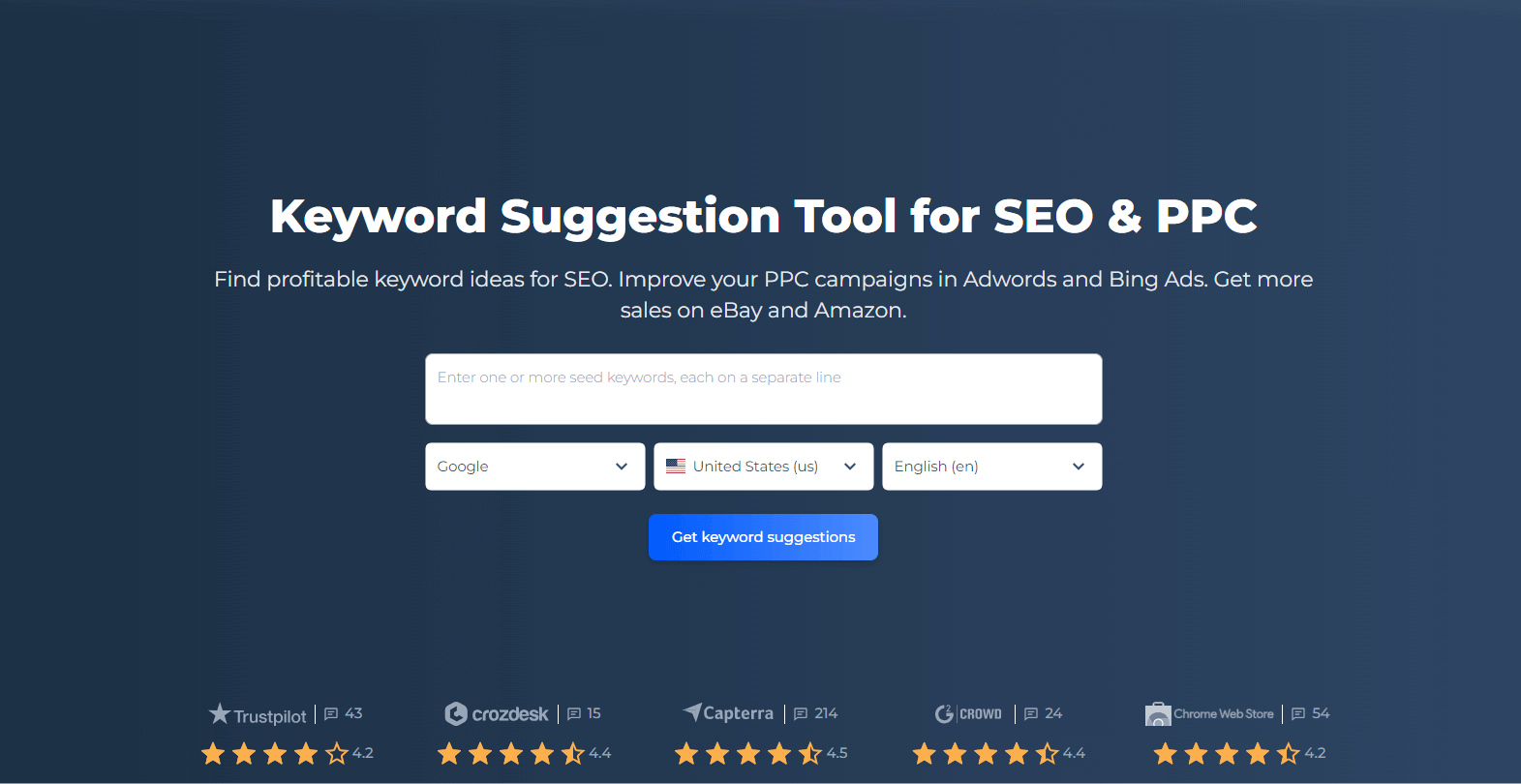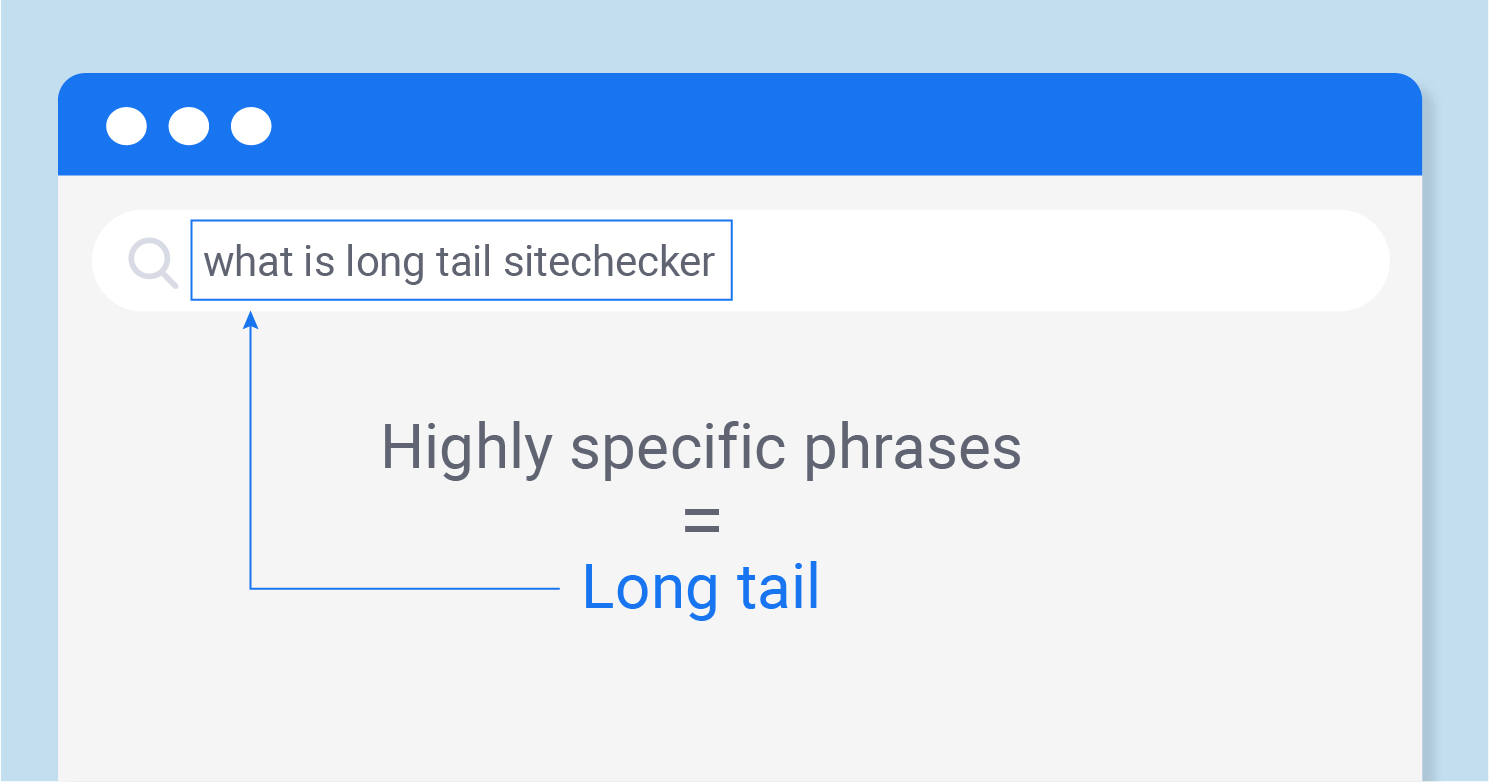What are Long-Tail Keywords?
Long-tail keywords are specific and often longer keyword phrases that visitors are more likely to use when they’re closer to the point of purchase or when they’re using voice search. They’re a little bit counterintuitive, at first, but they can be incredibly valuable if you know how to use them.
Take the term “shoes.” This is a short-tail keyword that’s broad and might be used by someone browsing or just beginning their search. Now, compare this to “men’s leather hiking boots size 11.” This keyword is much more specific, indicating the searcher knows exactly what they want. This specificity is a hallmark of a long-tail keyword.
The term “long-tail” is derived from the search demand curve, which is a graph that plots all terms by their search volume. Most of the search demand is made up of large volumes of queries that are searched for infrequently, creating a “long tail” in the graph. These infrequent search terms make up the majority of all search queries on the internet.
Here are a few key characteristics of long-tail keywords:
- Highly Specific: They target niche demographics rather than mass audiences.
- Lower Competition: Fewer websites are targeting these specific phrases, which means it’s easier to rank for these terms.
- Higher Conversion Rates: Because they’re more specific, they tend to draw in more qualified and conversion-ready traffic.
- Cost-Effective for Paid Ads: If you’re running pay-per-click (PPC) advertising campaigns, long-tail keywords often cost less per click compared to more common phrases.
In the world of SEO, long-tail keywords offer an opportunity. While they might not bring in massive volumes of traffic, the visitors they bring are more targeted and often more valuable. Whether you’re writing content for your website or investing in paid advertising, understanding and leveraging long-tail keywords can be a powerful tool in your digital marketing toolkit.
Why Should You Integrate Long-Tail Keywords in Your Blog Posts?
Integrating long-tail keywords into your blog posts is a strategic move for several compelling reasons. Here’s why:
| Targeted Traffic | As mentioned earlier, long-tail keywords are highly specific. This means that the audience reaching your blog through these terms is looking for something very particular. When they find content that precisely matches their search intent, they’re more likely to engage with it, be it reading the entire article, signing up for a newsletter, or making a purchase. |
| Higher Conversion Rates | Due to their specificity, long-tail keywords often lead to higher conversion rates. A user searching for “vegan leather jacket for women” is more likely to make a purchase than someone searching for just “jackets.” By targeting precise queries, you attract readers who are further down the sales funnel. |
| Less Competition | Broad keywords often have high competition, making it challenging for new or smaller websites to rank for them. In contrast, long-tail keywords, due to their niche nature, usually have less competition. This provides an opportunity for your blog to achieve higher rankings and gain visibility in search results. |
| Cost-Effective SEO Strategy | Trying to rank for popular, broad keywords can be expensive and time-consuming. On the other hand, focusing on a strategy built around long-tail keywords can be more cost-effective. With the right content, you can achieve good rankings without heavy investment. |
| Voice Search Optimization | With the rise of voice-activated assistants like Alexa, Siri, and Google Assistant, voice searches are becoming increasingly common. People tend to use more natural, longer sentences when speaking, which often aligns with long-tail keywords. By integrating them into your content, you make your blog more voice search-friendly. |
| Builds Authority | When you target long-tail keywords, you often end up covering very specific topics in depth. This not only provides value to your readers but also positions your blog as an authoritative source on the subject. |
| Diverse Traffic Sources | Relying solely on a few broad keywords can make your traffic sources limited. By targeting a variety of long-tail keywords, you diversify the sources of your traffic, making your blog’s audience more robust and less reliant on any single keyword. |
| Better User Experience | By catering to the specific needs and queries of your audience through long-tail keywords, you enhance the user experience. Readers are more likely to stay, explore, and return to a site that consistently addresses their specific questions and needs. |
In conclusion, while the temptation might be to go after those broad, high-volume terms, integrating long-tail keywords into your blog posts is a smart, strategic move. It not only boosts your blog’s visibility and authority but also drives targeted, conversion-ready traffic to your site.
Google About Long-Tail Keywords
John Mueller has tweeted several times about long-tail keywords, and his advice is generally consistent: focus on creating high-quality content that targets a few strong long-tail keywords, rather than creating many pages of weak content that target a lot of long-tail keywords.
In one tweet, Mueller said that “Long-tail keywords are important, but don’t overdo it. It’s better to have a few strong pages than many weak ones.” This suggests that Mueller believes that it’s more important to focus on creating content that is truly valuable to users, rather than trying to rank for as many long-tail keywords as possible.
In another tweet, Mueller said that “You can use long-tail keywords in your titles, descriptions, and content, but don’t force it. The most important thing is to write content that is informative and engaging for users.” This suggests that Mueller believes that long-tail keywords should be used naturally, and not forced into content in a way that makes it sound unnatural or spammy.
Overall, Mueller’s advice on long-tail keywords is to focus on quality over quantity. It’s better to have a few strong pages that target a few strong long-tail keywords, than to have many pages of weak content that target a lot of long-tail keywords.
Here are some specific examples of Mueller’s tweets about long-tail keywords:
How to Identify Long-Tail Keywords
Identifying long-tail keywords is a crucial step in optimizing your content for better search visibility and driving targeted traffic. Here’s a detailed guide on how to go about it:
1. Examine autocomplete suggestions in Google directly.
Google’s autocomplete feature is a treasure trove for discovering long-tail keywords. As you start typing a query into the search bar, Google suggests completions based on what other people are searching for. These suggestions often include long-tail variations of your initial query. For instance, if you type “best laptop for,” you might see suggestions like “best laptop for video editing” or “best laptop for students.” These are valuable long-tail keywords that real users are searching for.
2. Use question modifiers like “what” and “how.”
People often use questions when searching online. By prefixing your main phrases with question modifiers like “what,” “how,” “where,” “why,” and “when,” you can uncover a range of long-tail keyword opportunities. For example, “shoes” can be expanded to “what are the best shoes for hiking” or “how to clean leather shoes.”
3. Add qualifiers to short-tail keywords.
Qualifiers are words that you can add to your base keyword to make it more specific. Examples include adjectives, locations, or specific features. For “camera,” qualifiers might be “digital,” “professional,” “under $500,” or “for wildlife photography.” Each of these creates a more targeted long-tail keyword.
4. Look at your internal site search history.
If your website has a search function, examining the queries users input can be illuminating. This gives you direct insight into what your audience is interested in. Often, these search terms can be long-tail keywords that you might not have considered.
5. Research your competitors.
Competitor analysis tools like Semrush, Ahrefs, or Moz can help you see which long-tail keywords your competitors are ranking for. This can inspire your keyword research and help you discover gaps in your own content.
6. Run a gap analysis.
Gap analysis involves comparing your website’s keyword performance to that of your competitors. Identify phrases that your competitors are ranking for but you aren’t. Tools like Ahrefs’ “Content Gap” feature can help with this. You might discover long-tail keywords that are driving traffic to competitor sites but are absent from your content.
In conclusion, identifying long-tail keywords is a blend of leveraging technology and understanding user behavior. By tapping into these strategies, you can uncover a wealth of keywords that can drive targeted traffic and enhance your content’s performance in search results.
What Causes Long-Tail Keywords to Rank?
Ranking for long-tail keywords requires a combination of on-page and off-page SEO techniques. These terms, due to their specificity, can be easier to rank for, but they still require a strategic approach. Let’s delve into the factors that influence the ranking of long-tail keywords:
Keyword-Rich Headlines
One of the primary on-page SEO factors is the inclusion of the target keyword in the headline or title of the page. For long-tail keywords, a keyword-rich headline signals to search engines the primary focus of the content. By naturally incorporating the long-tail keyword into a compelling headline, you enhance the page’s relevance for that specific query, increasing the likelihood of ranking higher.
Internal Linking
Internal linking is the practice of linking one page of your website to another page on the same website. This serves a dual purpose:
- Navigation: It aids in website navigation, helping users find related content.
- Distributing Page Authority: Internal links distribute page authority throughout the site, boosting the ranking potential of individual pages.
For long-tail keywords, internal linking can be particularly beneficial. By linking to a page targeting a specific long-tail keyword from a more general or higher-authority page, you pass on some of that authority, bolstering the long-tail page’s chances of ranking.
Trusted Links
Backlinks, or external links pointing to your site, are a significant ranking factor. However, not all links are created equal. Links from trusted, authoritative sites carry more weight. For long-tail keyword pages, acquiring backlinks from reputable sources can significantly boost their ranking potential. These trusted links signal to search engines that your content is credible and valuable, deserving of a higher rank.
Social Engagement
While social signals (likes, shares, comments) aren’t direct ranking factors, they do play a role in content visibility and engagement. Content that receives high social engagement often sees an increase in organic traffic. When a piece targeting a long-tail keyword gets shared widely on social platforms, it can lead to:
- Increased Traffic: More users see and engage with your content.
- Higher Credibility: Social shares act as endorsements, signaling that users find your content valuable.
- More Backlink Opportunities: Popular content is more likely to be linked to by bloggers, journalists, or other content creators.
In conclusion, while long-tail keywords often face less competition than broader terms, they still require a strategic approach to rank. By focusing on keyword-rich headlines, smart internal linking, acquiring trusted backlinks, and fostering social engagement, you can optimize your content to achieve higher rankings for these specific queries.
How to Integrate Long-Tail Keywords Into Your Posts
Successfully integrating long-tail keywords into your posts goes beyond mere insertion. It requires a systematic approach that aligns with your overall content strategy, audience understanding, and the art of content creation. Let’s explore the steps to seamlessly weave these terms into your content:
1. Set Your Content Marketing Objectives
Before diving into keyword integration, it’s vital to have a clear understanding of your content’s purpose. Ask yourself:
– What do you aim to achieve? This could be increasing organic traffic, boosting sales, establishing authority, or enhancing user engagement.
– How do long-tail keywords fit into this objective? For instance, if your goal is to drive sales, targeting specific product-related long-tail keywords might be beneficial.
Setting clear objectives ensures that the integration of long-tail keywords aligns with your broader content and business goals.
2. Create Buyer Personas to Help You Understand User Intent
Understanding your audience is pivotal. By creating detailed buyer personas, you gain insight into:
– Demographics: Age, gender, location, occupation, etc.
– Psychographics: Interests, preferences, challenges, values, etc.
– Search Behavior: What are they likely to search for? What problems are they trying to solve?
With these personas, you can predict the long-tail keywords your audience might use. This understanding ensures that the queries you integrate resonate with your readers and match their search intent.
3. Research and Select Your Long-tail Keywords
With objectives set and personas in hand, dive into keyword research:
– Use Tools: Tools like Ubersuggest, SEMrush, or Ahrefs can provide long-tail keyword suggestions based on seed keywords.
– Analyze Competition: Look at what long-tail keywords your competitors are targeting. Can you compete, or are there gaps you can exploit?
– Check Search Volume and Difficulty: While long-tail keywords typically have lower search volumes, they should still have enough volume to warrant targeting. Also, consider the keyword difficulty or how hard it will be to rank for that keyword.
4. Write the Content
With your chosen long-tail keywords, it’s time to craft your content:
– Natural Integration: Ensure that the long-tail keywords flow naturally within the content. Avoid keyword stuffing, which can harm readability and SEO.
– Optimize Key Elements: Integrate the long-tail keyword in the title, meta description, headers, and throughout the content. But remember, always prioritize user experience.
– Provide Value: The content should address the user’s query comprehensively. If your long-tail keyword is a question, ensure your content provides a clear answer.
– Use Multimedia: Infographics, images, or videos can make your content more engaging. If using images, consider integrating the long-tail keyword into the alt text.
In conclusion, integrating long-tail keywords into your posts is a blend of strategy and art. By aligning with your content goals, understanding your audience, conducting thorough research, and crafting valuable content, you can seamlessly and effectively weave long-tail keywords into your blog posts.
Tools For Long-Tail Keyword Research
In the digital age, long-tail keyword research has become an essential task for content creators and marketers. Fortunately, there are numerous tools available, each with its unique features and benefits. Here’s a breakdown of some of the top tools for long-tail keyword research:
1. Sitechecker Keyword Suggestion Tool for SEO
The Keyword Suggestion Tool for SEO & PPC is an invaluable resource for digital marketers, SEO professionals, and content creators. This powerful tool aids in discovering a diverse range of relevant keywords tailored to enhance both Search Engine Optimization (SEO) and Pay-Per-Click (PPC) marketing strategies. By inputting a primary keyword, users receive a comprehensive list of related phrases, including long-tail variations, which are crucial for crafting targeted content and ads. This not only helps in improving organic search rankings but also in creating more effective paid search campaigns.

Additionally, the tool offers in-depth insights into each suggested keyword, such as search volume, competition level, and CPC (Cost-Per-Click) estimates. This data is pivotal for making informed decisions about which keywords to prioritize in your digital marketing campaigns. The tool’s user-friendly interface allows for easy exploration and comparison of keywords, assisting in fine-tuning your SEO and PPC efforts to reach the desired audience more effectively and efficiently. With the ability to export the findings, users can seamlessly integrate this data into their broader marketing strategy.
Get Top Keyword Suggestions!
Start building more effective SEO and PPC strategies today.
2. AnswerThePublic
A unique tool that visualizes search questions and suggested queries in an image called a search cloud. It’s excellent for uncovering questions and topics that people are searching for related to your seed keyword.
3. Semrush
A comprehensive SEO suite, Semrush offers a keyword magic tool that provides millions of keyword suggestions, including long-tail variations. You can also analyze keyword difficulty, search volume, and competitive density.
4. SEOmator
While primarily an SEO audit tool, SEOmator also offers keyword research functionalities. It provides long-tail suggestions and insights into search volume and competition.
5. KWFinder
Known for its user-friendly interface, KWFinder offers keyword suggestions along with crucial data like search volume, keyword difficulty, and current search results.
6. GrowthBar
A Chrome extension, GrowthBar provides keyword suggestions directly in the search results. It’s handy for quick research and competitor analysis.
7. SE Ranking
SE Ranking’s keyword research tool offers a comprehensive list of suggestions, including long-tail keywords. It provides data on search volume, competition, and cost-per-click (CPC).
8. Keyword Tool Dominator
This tool taps into the autocomplete databases from various search engines like Google, Amazon, and YouTube to provide long-tail keyword suggestions.
9. Wordtracker
Wordtracker provides thousands of keyword suggestions from Google, Amazon, YouTube, and more. It offers insights into competition data, search volume, and live SERP results.
10. Ubersuggest
Developed by Neil Patel, Ubersuggest provides keyword suggestions, search volume, and keyword difficulty. It also offers content ideas and backlink data.
11. LongTailPro
Specifically designed for long-tail keyword research, LongTailPro offers suggestions along with data on search volume, competition, and keyword profitability.
12. SECockpit
A robust keyword research tool, SECockpit provides data on organic competition, search volume, and keyword difficulty. It also offers content ideas and rank tracking functionalities.
13. Keywords Everywhere
A browser extension, Keywords Everywhere displays keyword data directly in search results, including search volume, CPC, and competition.
14. Google Trends
While not a traditional keyword research tool, Google Trends allows users to see the popularity of search queries over time. It’s valuable for spotting trending topics and seasonal variations in keyword popularity.
In conclusion, the choice of tool often depends on individual needs, budget, and preferences. It’s beneficial to use a combination of these tools to gain comprehensive insights and uncover a wide range of long-tail keyword opportunities.
Long-Tail Keyword Case Studies
Long-tail keywords have proven their worth time and again in the digital marketing landscape. By examining real-world case studies, we can glean insights into their effectiveness and learn strategies for our campaigns. Here are a few case studies that showcase the power of long-tail keywords:
1. E-commerce Store Boosts Sales by 30%
A small online boutique specializing in handmade crafts struggled to compete against larger e-commerce platforms. They decided to focus on long-tail keywords related to their niche products. Instead of targeting “handmade crafts,” they optimized for “handmade wooden jewelry box” or “artisanal scented soy candles.” Within three months, they observed a 30% increase in sales and ranked on the first page for several of their targeted long-tail keywords.
Key Takeaway: Niche businesses can leverage specific long-tail keywords to drive targeted traffic and bypass competition from larger platforms.
2. Blog Increases Organic Traffic by 50%
A health and wellness blog had plateaued in its organic traffic growth. They began targeting long-tail keywords like “natural remedies for winter colds” and “yoga exercises for lower back pain relief.” Not only did their organic traffic increase by 50% in six months, but the average session duration also improved, indicating higher user engagement.
Key Takeaway: Long-tail keywords can help content creators cater to specific user queries, resulting in higher engagement and visibility.
3. Tech Startup Enhances Lead Quality
A tech startup offering AI solutions for businesses had a decent inflow of leads but noticed a low conversion rate. They shifted their focus from broad terms like “AI for businesses” to long-tail keywords such as “AI solutions for supply chain optimization.” The result? A 20% increase in lead conversion rate, as the leads generated were from businesses specifically looking for supply chain solutions.
Key Takeaway: Long-tail keywords can significantly improve the quality of leads, ensuring higher conversion rates.
4. Local Bakery Dominates Local SEO
A local bakery in Boston was struggling to gain online visibility. They optimized their website for long-tail keywords like “best chocolate croissants in Boston” and “custom birthday cakes in Beacon Hill.” Soon, they were ranking at the top for these local-specific long-tail keywords and saw a surge in online orders and foot traffic.
Key Takeaway: Local businesses can dominate local SEO by targeting location-specific long-tail keywords.
5. Software Company Reduces Ad Spend by 40%
A software company was spending a significant amount on PPC campaigns targeting broad keywords. They shifted their strategy to target long-tail keywords like “CRM software for healthcare providers.” The result was a 40% reduction in ad spend, with a 10% increase in click-through rates.
Key Takeaway: Long-tail keywords, due to lower competition, can be more cost-effective in paid advertising campaigns.
In conclusion, these case studies underscore the transformative power of long-tail keywords. Whether you’re a small business, a content creator, or a large corporation, integrating long-tail keywords into your digital strategy can lead to tangible benefits in visibility, engagement, and conversions.
Myths About Long-Tail Keywords
Long-tail keywords have become integral to SEO and content marketing strategies. However, as with many concepts in the digital realm, misconceptions abound. Let’s debunk some common myths surrounding long-tail keywords:
1. Long-tail Keywords Always Have Low Search Volume
While it’s true that many long-tail keywords have lower search volumes compared to broader keywords, it’s not a universal rule. Some long-tail keywords can garner significant search traffic, especially if they tap into a trending topic or a niche with a large audience.
Key Takeaway: Don’t dismiss a long-tail keyword solely based on search volume. Its specificity might lead to higher conversions.
2. They’re Only Beneficial for Niche Markets
While niche markets can certainly benefit from targeting specific keyword phrases, mainstream industries can also leverage long-tail keywords to address particular segments of their audience or highlight unique selling points.
Key Takeaway: Every industry, regardless of its size, can find value in long-tail keywords.
3. It’s Easy to Rank for Long-tail Keywords
While there’s generally less competition for long-tail keywords, it doesn’t automatically guarantee high rankings. SEO best practices, quality content, and authoritative backlinks are still crucial.
Key Takeaway: Long-tail keywords provide an opportunity, but they still require a comprehensive SEO strategy.
4. They’re Not Suitable for PPC Campaigns
Some marketers believe that the low search volume of long-tail keywords makes them unsuitable for PPC campaigns. However, their specificity often results in higher click-through and conversion rates, making them cost-effective in many scenarios.
Key Takeaway: Long-tail keywords can offer a favorable ROI in PPC campaigns due to their targeted nature.
5. The Longer the Keyword, the Better
It’s a misconception that just by adding more words or making a keyword longer, it becomes a good long-tail keyword. The essence of a long-tail keyword is its specificity, not necessarily its length.
Key Takeaway: Focus on the relevance and specificity of the keyword, not just its length.
6. They Don’t Work for Voice Search
With the rise of voice assistants, there’s a myth that long-tail keywords aren’t suited for voice search. In reality, voice searches are often more conversational and specific, aligning well with long-tail keywords.
Key Takeaway: Long-tail keywords can be optimized for voice search by understanding the conversational queries users might pose.
7. They’re Only for Blog Content
While blog posts are a great place to incorporate long-tail keywords, they can also be integrated into product pages, FAQ sections, video descriptions, and more.
Key Takeaway: Diversify your use of long-tail keywords across different types of content.
In conclusion, while long-tail keywords present numerous advantages, it’s essential to approach them with a well-informed perspective. Dispelling these myths can help marketers and content creators utilize long-tail keywords more effectively in their strategies.
Conclusion
Long-tail keywords remain a cornerstone of effective digital marketing and SEO strategies. Their specificity caters to targeted audiences, often leading to higher engagement and conversion rates. With the rise of voice search and evolving user behavior, these keywords have found even more relevance in today’s digital landscape. By understanding their nuances, leveraging the right tools, and debunking prevalent myths, marketers can harness the full potential of long-tail keywords to drive meaningful results. As with all digital strategies, staying informed and adaptable is key to long-term success.





